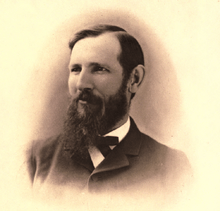Joel Asaph Allen
| Joel Asaph Allen | |
|---|---|
 Joel Asaph Allen | |
| Born |
July 19, 1838 Springfield, Massachusetts |
| Died |
August 29, 1921 (aged 83) USA |
| Residence | USA |
| Nationality | American |
| Fields | |
| Institutions |
American Academy of Arts and Sciences Museum of Comparative Zoology American Association for the Advancement of Science Audubon Society American Philosophical Society |
| Alma mater | Harvard University |
| Known for | Allen's rule |
Joel Asaph Allen (July 19, 1838 – August 29, 1921) was an American zoologist, mammalogist and ornithologist.
He became the first president of the American Ornithologists' Union, the first curator of birds and mammals at the American Museum of Natural History, and the first head of that museum's Department of Ornithology.
He is remembered for Allen's rule, which states that the bodies of endotherms (warm-blooded animals) vary in shape with climate, having increased surface area in hot climates to lose heat, and minimized surface area in cold climates, to conserve heat.
Early life
Allen was born in Springfield, Massachusetts to Joel Allen and Harriet Trumbull. He studied and collected specimen of natural history early in life, but he forced to sell his relative large collection so that he could attend the Wilbraham & Monson Academy in 1861. The following year, he transferred to Harvard University, where he studied under Louis Agassiz.
Career as a Field Collector of Natural History
In 1865, he took part in his mentor's 1865 expedition to Brazil in search of evidence of an ice age there, which Agassiz later claimed to have found. After returning to Massachusetts, chronic ill health caused him to return to his family farm in Springfield.[1]
By 1867, Allen's health had improved enough that he went on a flurry of collecting trips, including at Sodus Bay, and in Illinois, Michigan and Indiana. Upon his return to Massachusetts, he took the position of curator of birds and mammals at Harvard's Museum of Comparative Zoology. In the winter of 1868-1869, he was one of two ornithologists, the other being Charles Johnson Maynard, to explore the relatively unknown state of Florida, which was then still very much a wilderness in the late 1860s.[1] When he returned, he wrote a celebrated analysis of his trip entitled On the Mammals and Winter Birds of Eastern Florida, which was published in 1871. That same year he was elected a Fellow of the American Academy of Arts and Sciences.[2]
For the next couple of years, Allen ventured to the Great Plains, Rocky Mountains and the Dakota Territory on collecting trips for Harvard's museum. Except for an 1882 collecting trip in Colorado with fellow ornithologist William Brewster, Allen never went field collecting again, primarily because of his fragile health.[1]
Career as a Researcher and Leading Figure of Natural History
Following the end of his field collecting days, Allen dedicated his life to research and editorial publication. In the early summer of 1876, Allen was elected by the Nuttall Ornithological Club to replace Charles Johnson Maynard and Henry Augustus Purdie as editor of their Bulletin. In 1883, Allen, along with William Brewster and Elliott Coues created the American Ornithologists' Union. Allen, who was an ill health, was unable to attend their inaugural meeting, but was elected their first president, nonetheless. He also became the chief editor of their journal, The Auk.[1]
In 1885 he was appointed as the first curator of birds and mammals at the American Museum of Natural History in New York, later becoming the first head of the museum's Department of Ornithology. In 1886, he was one of the incorporators of the first Audubon Society, New York City. He was a member of the American Association for the Advancement of Science, and of the American Philosophical Society.[3]
The hundreds of letters which Elliott Coues (pronounced "cows") sent to him over many decades form one of the cornerstones of the history of American ornithology. Allen famously memorialized Coues[4] in the pages of The Auk, the A.O.U.'s journal, after the latter's death in 1899.
He formulated what is now known as Allen's rule, stating a correlation between body shape and climate, in 1877.
Allen used the initials J.A.A. when signing his many book reviews in The Auk.
Bibliography
- On the Mammals and Winter Birds of Eastern Florida (1871)
- The American Bisons (1876)
- History of the American Bison, Bison americanus (1877)
- Monographs of North American Rodentia (with Elliott Coues 1877)
- History of North American Pinnipedia (1880)
- The Right Whale of the North Atlantic (1883)
- Mammals of Southern Patagonia (1905)
- The Influence of Physical Conditions in the Genesis of Species (1905)
- Ontogenetic and Other Variations in Musk-Oxen (1913)
References
- 1 2 3 4 Chapman, Frank. "In Memoriam: Joel Asaph Allen". The Auk. vol. 39, 1922.
- ↑ "Book of Members, 1780-2010: Chapter A" (PDF). American Academy of Arts and Sciences. Retrieved 15 April 2011.
- ↑ "Whonamedit - dictionary of medical eponyms".
- ↑ Allen, Joel Asaph. Biographical Memoir of Elliott Coues 1842-1899. National Academy of Sciences, 1909.
External links
| Wikimedia Commons has media related to Joel Asaph Allen. |
- Works by Joel Asaph Allen at Project Gutenberg
- Works by or about Joel Asaph Allen at Internet Archive
- National Academy of Sciences Biographical Memoir